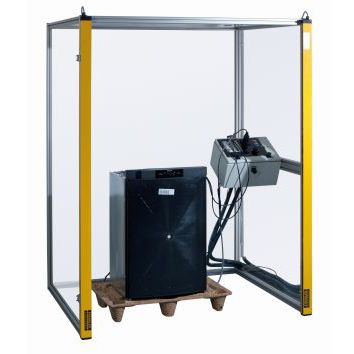SCHLEICH test stations with safety light curtain are a solid, long-life investment to reduce the operator’s risk. Ergonomics are the main reason of this safety device.
The use of an optoelectronic safety light curtain is less restrictive in terms of handling. It improves productivity – but also somewhat restricts safety. With the appropriate design, it is ensured that when a person falls into the test station, the test object is voltage-free and discharged quickly enough. For this purpose, however, a prescribed safety distance must be maintained around the test object. These are not insignificant and can be between 10-30 cm depending on the application. This can restrict the ergonomics and handling of large or heavy test DUTs.
In addition, mechanical movements must be stopped safely within the shortest possible time. For example, electric motors with freely accessible shafts must stop very quickly before they can be touched. This can also mean that a safety light curtain cannot be used.
Most safety light curtains have a beam distance of 14mm. This makes the light barrier finger-safe. However, it is not possible to reliably identify cables coming out of the test room. Despite various design measures, it is possible that thin cables outside the light curtain are not detectable. This can lead to dangerous voltage transmission to the outside.
These factors may make additional safety measures necessary. However, it could also be that the use of a safety light curtain is excluded.
To protect sensitive electronic DUTs from electrostatic charging and discharging, test stations are optionally made of ESD materials.



